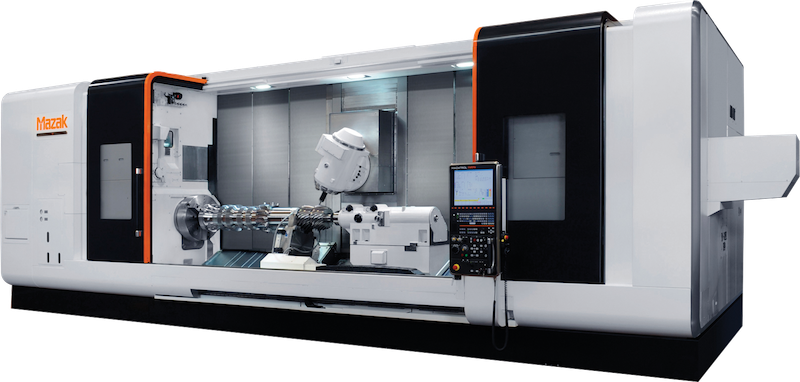By Richard McCauley, General Manager, Mazak Western Headquarters and Technology Center
 The aerospace industry today is a hotbed of manufacturing activity and advanced machine tool technology. At Mazak, we see a strong trend of increased interest in machine tools with 5-axis capabilities for aerospace part machining. It’s very similar to the early days of mill-turn machines, when manufacturers began to recognize the benefits of adding milling and drilling capabilities to standard 2-axis lathes.
The aerospace industry today is a hotbed of manufacturing activity and advanced machine tool technology. At Mazak, we see a strong trend of increased interest in machine tools with 5-axis capabilities for aerospace part machining. It’s very similar to the early days of mill-turn machines, when manufacturers began to recognize the benefits of adding milling and drilling capabilities to standard 2-axis lathes.
A key factor in the growing acceptance of 5-axis technology is the lower price point today for 5-axis equipment. In addition, the software that supports 5-axis machining is more friendly and, again, not as expensive as it was in the past. With 5-axis technology manufacturers can machine parts in one or two operations that previously required four or five. Therefore, these machines save time and ensure part accuracy by eliminating errors that can occur as a part moves through multiple setups.
From a workpiece material point of view, aerospace manufacturers want machines that have high rigidity and high-torque spindle capabilities to process the tough, high-alloy materials and titaniums that are common in their industry. But beyond those sorts of basic machine tool capabilities, there are no typical or “go to” machine types or sizes for aerospace applications, simply because there are so many different sizes and functions of aircraft parts.

Today, there are hundreds of machine tool configurations from which to choose. They include, for example, machines used for production of smaller to medium-size structural components, such as Mazak’s smallest 15-hp NEXUS verticals that can handle workpieces up to 35" x 16" x 22". On the other side of the size and power range are INTEGREX e-HORIZONTAL Series machines that fuse a CNC turning center with a full 5-axis machining center. With two main spindles possessing up to 60-hp each and a 50-hp milling spindle, the machines can handle parts up to 51"-dia and 320" long and facilitate DONE IN ONE processing of large parts with complex geometries.
Specific machines aside, a consistent trend in aerospace machining is close collaboration between machine tool builders and their customers in manufacturing. Development of large-scale aerospace machining systems understandably is a very deliberate and time-consuming process. It typically begins when machine tool sales personnel establish a relationship with the manufacturer by outlining available machine capabilities that can potentially fulfill the manufacturer’s needs. Then the machine tool builder’s application engineers meet with the manufacturer’s production engineers and determine what the manufacturer specifically wants to do on a particular project.
For example, with an existing product, the goal may be process improvements aimed at achieving better accuracy, better finish, and better parts. In another situation, a manufacturer may have been told that production rates for a particular component are going to increase over the next year, so the interest is in machines that will support higher production levels. Of course, there also exist clean-sheet new projects where collaboration at the earliest stages of production planning will result in maximum productivity, efficiency and savings.
At Mazak, our application engineers ask the customer’s engineers a lot of questions,  get the prints of the part to be machined and form an understanding of what is required. Then, we help the customer select a machine that will eliminate process steps and finish a part in as few handlings as possible. The final proposal can include automation, software, and training recommendations as well as machine tool specifications.
get the prints of the part to be machined and form an understanding of what is required. Then, we help the customer select a machine that will eliminate process steps and finish a part in as few handlings as possible. The final proposal can include automation, software, and training recommendations as well as machine tool specifications.
For a major project, the time that elapses between initial contact with the manufacturer until a machining system is functioning on the shop floor may be a year or more. On the other hand, for instance, a second or third tier supplier may receive word that his quantities of hydraulic line connectors for the 737 are going to double. He calls us and says he needs a machine. In that situation, the machine selection process is more simple and must move faster.
In any case, the key factor is the participation of our application engineers. Mazak engineers are intense, aware of what they do, and have a lot of fun when they are doing it. They are deeply knowledgeable about manufacturing technology; the nine engineers that I work with together have about 150 years of experience. Overall, Mazak has six regional Technology Centers that provide application engineering, machining demonstrations, and comprehensive training in close proximity to customers.
It is clear that the non-hardware aspects of machine tool technology play a crucial role in handling the strong and growing demand for advanced aerospace components.
About the Author
Richard is the general manager of the Mazak Western Regional Headquarters and Technology Center in Gardena, California. He is responsible for ensuring Mazak customers from all industry segments, especially those within the aerospace sector, receive the most innovative ideas for increasing productivity, efficiency and equipment utilization. When not at work, he and his wife, Robin, volunteer at church, visit with friends, and raise their recently adopted 7-year-old daughter, Bethany, who has been in their care for more than two years. He never thought he would be one to enjoy reading about Junie B. Jones and her first-grade adventures or the fact that the Disney movie “Tangled” would be among his favorites.
